Air Conditioning probably has decreased vitamin D
http://en.wikipedia.org/wiki/Airconditioner#Homeairconditioningsystemsaroundthe_world
Domestic air conditioning is most prevalent and ubiquitous in developed Asian and Middle Eastern nations and territories, such as Japan, Taiwan, South Korea, Singapore, Hong Kong, Israel, China and the Persian Gulf States such as Bahrain, Kuwait, and the United Arab Emirates. This especially applies to Singapore and Hong Kong due to most of the population living in small high-rise flats. In these areas, with high summer temperatures and a high standard of living, air conditioning is considered a necessity and not a luxury. Japanese-made domestic air conditioners are usually window or split types, the latter being more modern and expensive. In Israel, virtually all residential systems are split types. Air conditioning is also increasing in popularity with the rising standard of living in tropical Asian nations such as Thailand, India, Pakistan, Malaysia, and the Philippines.
In the United States, home air conditioning is most prevalent in the South/Southwest and on the East Coast, areas in which it has reached the ubiquity it enjoys in East Asia.[citation needed] Central air systems are most common in the United States, and are virtually standard in all new dwellings in most states.
Air conditioning has allowed people around the world to get out of the heat
But getting out of the heat has also resulted in decreased vitamin D during the past 40+ years
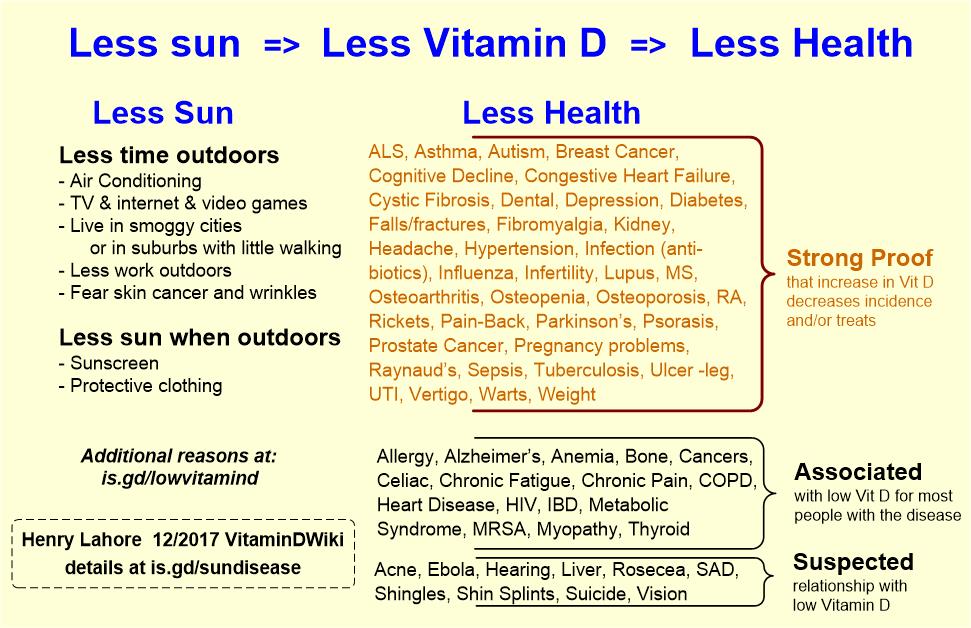
Even Arabs and Indians are getting out of the heat and are becoming vitamin D deficient. - many articles in VitaminDWiki
Until recently people in the US were much more likely to get MS and some other diseases if they lived in the North
US military has also noticed the MS latitude effect decreasing during the 20th century file
However, now that people in the Southern portion of the US are staying indoors more the health benefits of living in the South is disappearing.
Even in Brazil there is no longer much change in vitamin D levels between summer and winter
Now there is a low level of vitamin D even in sunny portions of the US
May 2010 book: Losing Our Cool
Book review in LA Times In 1960, A/C in 12% of U.S. homes, now 85%.
Chapter 7. India: Where “A/C” Means “VIP” The new frontiers of climate control in one of the planet's hottest regions.
Also mentions: a Danish study found, individuals eat more in cool environments.
From the same magazine interview
Whereas homes used to feature big awnings and porches, and many windows for cross-drafts, now they’re built around air conditioners—and windows are sealed shut. Inadequate ventilation is linked to asthma and allergies. The suspected culprits, writes Cox, include “volatile organic compounds, moulds, and allergens in floor dust,” and bacteria, which air conditioners harness inside their coils and drip pans, and disperse.
This ignores the possibility that decreased sunlight -> decreased vitamin D -> decreased ability to fend off asthma and allergies
Air-conditioning now accounts for almost 20 percent of year-round electricity consumption by American homes.
Residential air-conditioning units in service in 2005 were an impressive 28 percent more energy-efficient on average than they were in 1993.
New federal standards will result in another 30 percent more efficiency.
In addition to lower operational cost, they also cost less to purchase.
Snips from the book
pg 123 Twenty researchers published 10 "equally compelling" reasons for obesity: sleep loss, endocine disruption, decreased smoking, aging of the population, increases in age at childbearing, effects of fetal development, pharmaceutical use, natural selection, and mating preferences. They listed "reduction in variability of ambient temperature" as a potential villain.
pg 124 one researcher wrote in the 1970's 'Cattle, swine, rate, goats, and the US Army men all eat more when the temperature is low than when it is high"
pg 125 Japan air conditioners 5.7% of homes in 1970, 87.1% in 2004 - with 99% in Tokyo
pg 129 Before 1930 there was a strong seasonality of births, with temperature having a secondary influence
Hours of use of air conditioner in US - probably 2010
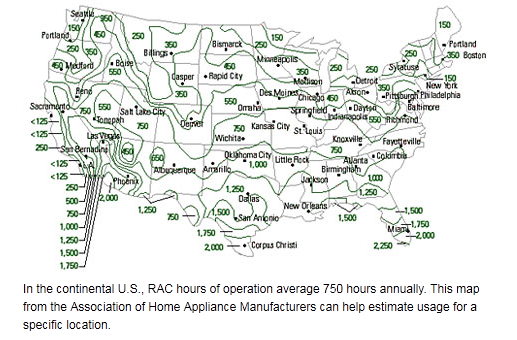
Increased US air conditioning ownership
According to the Census Bureau
10% in 1960.
49% in 1973,
89% in 2013 (?)
Everyone in US getting air conditioning - even the poor
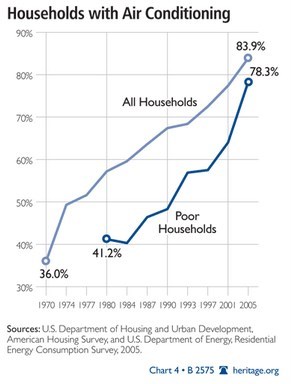
See also VitaminDWiki
Diabetes rising quickly in areas with recent air conditioning – June 2011
Hypothesis – China air conditioning disease is the result of less vitamin D – March 2011
Perhaps Italians have air conditioning too: lower latitudes have less vitamin D – July 2013
Air conditioning has not totally canceled the latitude effective in the US yet – July 2013
Far more hot days and air conditioning (and thus less vitamin D) later this century – June 2014
Does less sun mean more disease? video by VitaminDWiki - 5 minutes (2014)
See also web
- Potential energy demand for cooling in the 50 largest metropolitan areas of the world 2009
- For example, the potential cooling demand in just one city in India, Mumbai is about 24% of the demand for the entire United States.
- Relief in Every Window, but Global Worry Too New York Times June 2012 has the following image

In 50 years more power will be used for Air Conditioning than for heating
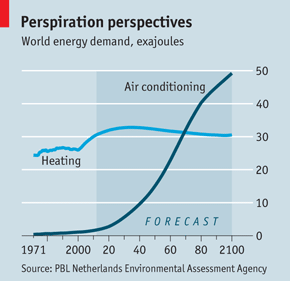
By 2050 2/3 of all households on Earth will have air conditioning
There’s a simple way to ditch air-conditioning when it’s scorching hot. But we’re ignoring it Fast Company July 2019]
" It’s predicted that around two-thirds of the world’s households could have an air conditioner by 2050, and the demand for energy to cool buildings will triple."
- Thus we can expect Vitamin D levels around the world to continue to drop for many decades
AC unit growth from 2016-2050
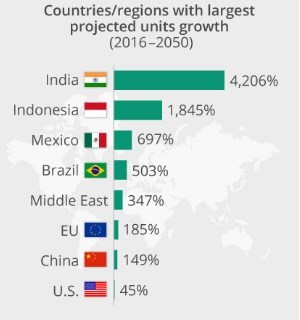
::This page has been evolving since early 2010::
